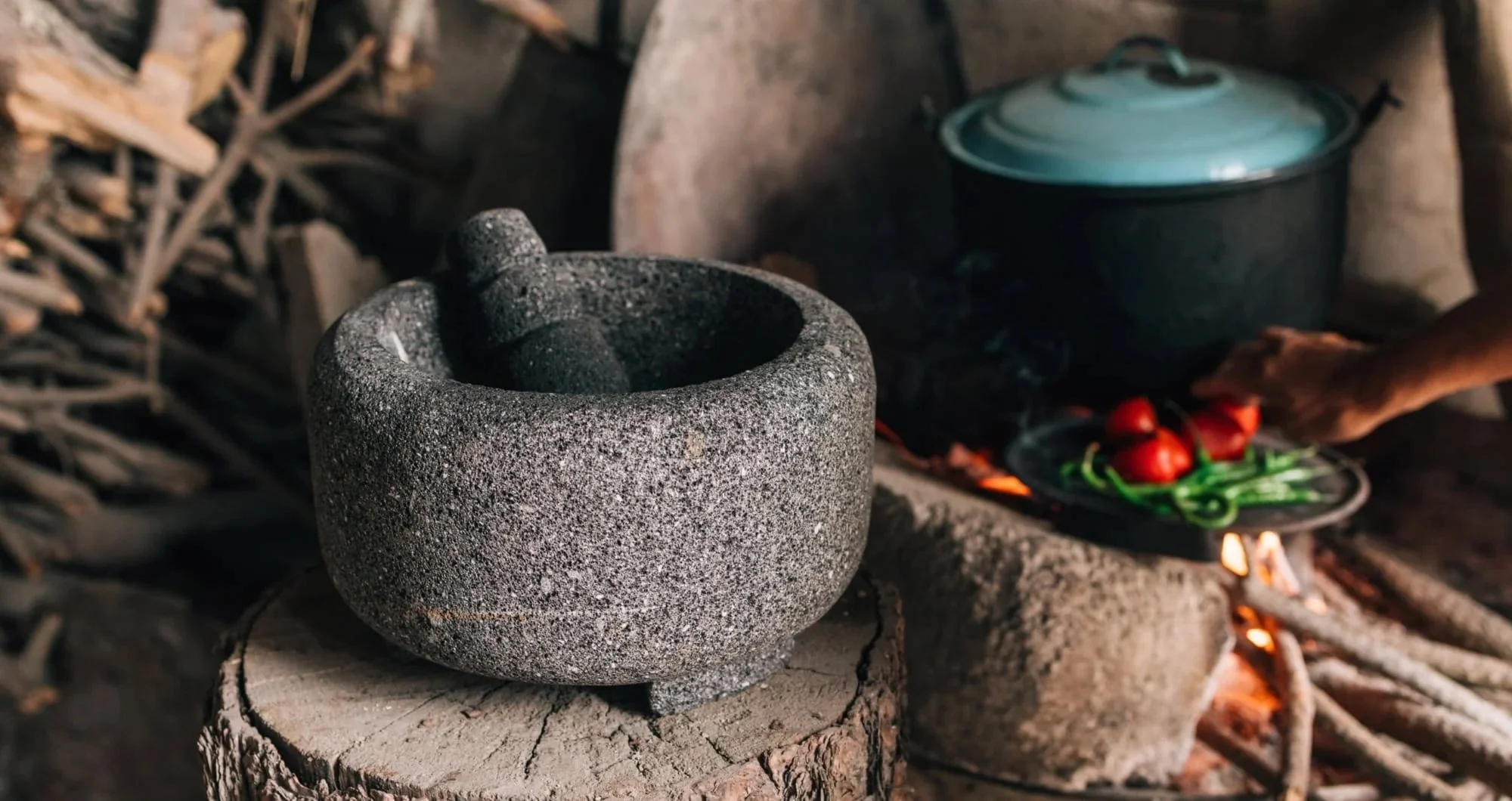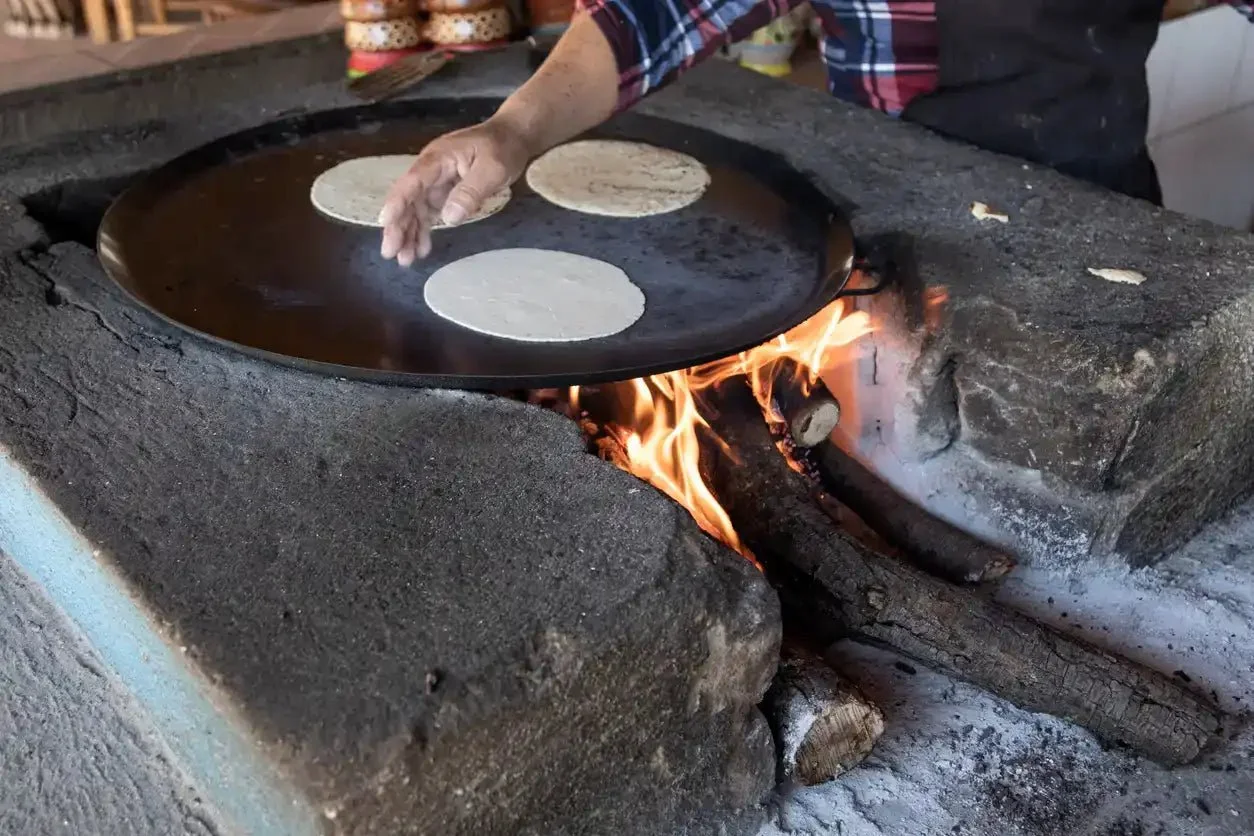Traditional Mexican Cooking Techniques: Mastering Nixtamalization, Molcajete Grinding, and Comal Cooking
Mexican cuisine represents one of the world's most sophisticated culinary traditions, built upon ancient techniques that have been refined over thousands of years. What defines traditional Mexican dishes is reflected in three time-honored methods, that stand out as fundamental to authentic Mexican cooking: nixtamalization, molcajete grinding, and comal cooking. These traditional techniques not only create distinctive flavors and textures but also offer significant nutritional benefits and cultural connections to Mexico's rich culinary heritage.
Understanding these traditional Mexican cooking methods provides home cooks with the knowledge to create truly authentic dishes while appreciating the ingenuity of ancient Mesoamerican civilizations. Each technique serves specific purposes that modern appliances cannot fully replicate, making them essential skills for anyone serious about Mexican cuisine.
What is Nixtamalization?
Nixtamalization is the ancient process of treating dried corn kernels with an alkaline solution, typically calcium hydroxide (cal or slaked lime), to transform them into nixtamal. This technique, whose name derives from the Nahuatl words "nextli" (ashes) and "tamalli" (corn dough), represents one of humanity's earliest food processing innovations, dating back over 3,500 years.
The process involves boiling corn kernels in alkaline water for 20-30 minutes, then allowing them to steep overnight. During this time, the alkaline solution softens the pericarp (outer hull) of the corn, making it easier to remove, while simultaneously triggering chemical changes that improve the corn's nutritional profile and functionality.
How to Nixtamalize Corn
Traditional nixtamalization requires careful attention to ratios and timing. Begin with two cups of dried field corn, preferably dent corn varieties like White Olotillo. Add one tablespoon of food-grade calcium hydroxide to seven to eight cups of water in a non-reactive stainless steel pot, stirring thoroughly to dissolve the lime completely.
Add the corn to the alkaline solution and bring to a boil over medium-high heat. Reduce to a simmer and cook for 20-30 minutes, stirring occasionally, until the outer hulls begin to loosen and slide off easily when rubbed between your fingers. The kernels should be tender on the outside but still firm in the center.
Remove from heat and cover the pot, ensuring the corn remains completely submerged in the alkaline liquid. Allow this mixture to steep at room temperature for 8-12 hours or overnight. This steeping period is crucial as it allows the alkaline solution to penetrate the kernels fully, completing the chemical transformation.
After steeping, drain the corn and rinse thoroughly under cold running water while rubbing the kernels between your hands to remove the loosened hulls. Continue rinsing until the water runs clear and most of the hulls have been removed. The resulting nixtamal can be used immediately or stored in the refrigerator for up to five days.
Nixtamalization Benefits
The nutritional benefits of nixtamalization are remarkable and demonstrate the sophisticated understanding ancient Mesoamericans had of food science. This process increases the bioavailability of niacin (Vitamin B3) by up to 750 percent, preventing pellagra, a potentially fatal disease caused by niacin deficiency. You can read more about nixtamalized corn in our Essential Ingredients Guide.
The alkaline treatment significantly increases calcium content, with some nixtamalized corn products containing up to 750 percent more calcium than untreated corn. This calcium absorption occurs when the lime solution penetrates the corn kernels, making tortillas and other masa products excellent sources of this essential mineral.
Nixtamalization also reduces phytic acid content by approximately 50 percent, which normally binds minerals and prevents their absorption in the digestive system. This reduction allows the body to better utilize the zinc, iron, and other minerals naturally present in corn.
The process creates resistant starch, which acts as prebiotic fiber that feeds beneficial gut bacteria. This unique carbohydrate helps regulate blood sugar levels and may contribute to improved digestive health and cholesterol management.
From a culinary perspective, nixtamalization transforms corn's protein structure, allowing it to form cohesive dough when ground. Without this process, corn flour cannot bind properly, making it impossible to create pliable tortillas or properly textured tamales.
Nutritional benefits of nixtamalization
Historical Significance of Nixtamalization
The discovery of nixtamalization revolutionized Mesoamerican civilizations, enabling populations to thrive on corn-based diets without suffering nutritional deficiencies. This process allowed the Aztecs, Mayans, and other indigenous groups to develop complex societies supported by reliable food sources.
When Spanish colonizers brought corn to Europe and other parts of the world, they failed to understand or adopt the nixtamalization process. This oversight led to widespread pellagra outbreaks in populations that relied heavily on corn, particularly in the American South, parts of Europe, and Africa during the 18th and 19th centuries.
The contrast between healthy indigenous populations in Mexico and Central America and the pellagra-stricken populations elsewhere demonstrates the critical importance of this ancient technique. Modern understanding of nixtamalization has led to its adoption in industrial food production, ensuring the nutritional quality of mass-produced corn products.
The molcajete, derived from the Nahuatl word "mollicaxtli" meaning "stone box for making salsa," represents the Mexican version of a mortar and pestle. Carved from volcanic basalt rock, this three-legged grinding tool has been used in Mesoamerica for over 6,000 years and remains indispensable in Mexican kitchens today.
Authentic molcajetes are hand-carved from single pieces of volcanic rock, creating a porous surface that aids in grinding while gradually becoming seasoned with use. The tejolote (pestle) is crafted from the same volcanic stone, designed to work in harmony with the molcajete's interior surface.
How to Molcajete Grinding
Proper molcajete technique involves understanding the tool's unique grinding action. Unlike modern blenders that slice ingredients with sharp blades, molcajetes crush and bruise plant cells, releasing essential oils and volatile compounds that create superior flavors in salsas, spice blends, and pastes.
Begin by placing ingredients in the molcajete's center, starting with the hardest components like garlic or dried chiles. Use the tejolote to crush these ingredients using a rocking motion, gradually working outward toward the molcajete's walls. Apply steady, firm pressure while maintaining the rocking motion to achieve thorough crushing.
The key to effective molcajete grinding lies in patience and proper technique. Rather than trying to pulverize everything at once, work ingredients in stages, adding softer components like tomatoes or fresh herbs after harder ingredients have been properly crushed. This staged approach prevents over-processing while ensuring each ingredient contributes its maximum flavor potential.
For salsas, begin with salt and hard aromatics like garlic and dried chiles, grinding until they form a rough paste. Add tomatoes or tomatillos next, crushing them to release their juices while maintaining some texture. Finish with fresh herbs like cilantro, folding them in gently to preserve their bright flavors.
Molcajete
Traditional Mexican Cooking Methods with Molcajetes
Molcajetes excel at creating traditional Mexican preparations that require specific textures and flavor releases. Guacamole prepared in a molcajete achieves the perfect balance of creamy and chunky textures while releasing avocado oils that enhance richness and mouthfeel.
Salsa preparation in molcajetes creates superior flavor profiles compared to machine-processed versions. The crushing action releases more volatile compounds from chiles and aromatics, creating deeper, more complex flavors. The resulting texture combines smooth pastes with distinct chunks, providing textural interest that machine processing cannot replicate.
Spice grinding in molcajetes allows for precise control over texture and ensures maximum flavor extraction. Whole spices like cumin, coriander, and peppercorns release their essential oils more effectively when crushed rather than chopped, creating more aromatic and flavorful spice blends.
Molcajete Seasoning and Care
New molcajetes require curing before use to remove loose particles and grit from the volcanic stone. This process involves grinding uncooked rice with coarse salt repeatedly until the rice powder comes out clean and white, indicating that loose particles have been removed.
Begin curing by washing the molcajete with warm water and a stiff brush, then allowing it to dry completely. Add a quarter cup of uncooked rice and a tablespoon of coarse salt to the molcajete, then grind with the tejolote using firm pressure and circular motions. Continue grinding until the rice becomes a fine powder, covering the entire interior surface.
Examine the rice powder for gray coloration or grit, which indicates loose particles from the stone. Discard the rice powder and rinse the molcajete thoroughly. Repeat this process three to five times, or until the rice powder remains white and free of grit.
After the rice curing process, many cooks perform a final seasoning step using garlic, salt, and sometimes dried chiles. This creates a base flavor layer that enhances future preparations while further smoothing the molcajete's surface.
Daily maintenance of molcajetes involves rinsing with warm water and scrubbing with a stiff brush to remove food particles. Never use soap, as it can be absorbed by the porous stone and affect future flavors. Allow the molcajete to air dry completely before storing to prevent moisture retention that could lead to cracking.
Understanding the Comal
The comal, derived from the Nahuatl word "comalli," represents the fundamental cooking surface for Mexican cuisine. This flat, round griddle traditionally made from clay has evolved to include cast iron, carbon steel, and stainless steel versions, each offering unique cooking characteristics.
Traditional clay comals provide even heat distribution and impart subtle earthy flavors to foods, while modern metal versions offer durability and faster heating. The choice of comal material depends on cooking preferences, maintenance requirements, and desired flavor profiles. To explore the full range of traditional Mexican cooking equipment and their historical significance, read our comprehensive The Ultimate Guide to Traditional Mexican Cooking Tools: History, Uses, and Care.
Proper comal technique begins with understanding heat management and surface preparation. Preheat the comal over medium heat for several minutes, allowing it to reach an even temperature across its surface. Test the temperature by sprinkling a few drops of water onto the comal; they should sizzle and evaporate quickly when properly heated.
For tortilla cooking, place pressed masa discs directly onto the heated comal without oil. Cook for 30-45 seconds until the edges begin to dry and turn opaque, then flip using fingers or a spatula. The tortilla should begin to puff slightly on the second side, indicating steam formation within the masa layers.
Vegetable roasting on comals requires higher heat and careful monitoring. Place vegetables like tomatoes, onions, and chiles directly on the heated surface, turning frequently to achieve even charring. The goal is to develop complex flavors through controlled burning while maintaining the vegetables' structural integrity.
Spice toasting on comals awakens dormant flavors in whole spices and dried chiles. Toast spices over medium heat, stirring constantly to prevent burning. Seeds and small spices typically require 1-2 minutes, while larger items like dried chiles may need 3-5 minutes per side.
Authentic Mexican comal
Traditional Mexican Cooking Methods with Comals
Comal cooking encompasses numerous traditional techniques that create distinctive flavors impossible to achieve with modern pans. The direct heat contact and minimal oil usage create unique flavor development through controlled charring and moisture evaporation.
Vegetable preparation for salsas benefits enormously from comal cooking. Tomatoes, tomatillos, onions, and garlic develop complex, smoky flavors when charred on comals. The controlled burning creates new flavor compounds while concentrating existing ones through moisture loss.
Quesadilla preparation on comals allows for precise cheese melting while achieving perfectly crispy tortilla exteriors. The even heat distribution prevents hot spots that could burn the tortilla before the cheese melts, resulting in perfectly balanced textures.
Meat cooking on comals works particularly well for thin cuts that benefit from high heat and quick cooking. Carne asada, thin steaks, and chicken breasts develop excellent crusts while maintaining juicy interiors when properly cooked on seasoned comals.
Comal Seasoning and Maintenance
Metal comals require seasoning similar to cast iron cookware to develop non-stick surfaces and prevent rust. Begin by washing the new comal with warm, soapy water and drying thoroughly. This is the only time soap should be used on the comal.
Apply a thin layer of high-smoke-point oil like grapeseed or avocado oil to the entire comal surface, including the bottom and edges. Heat the comal over medium-low heat for 2-3 minutes, then wipe away excess oil with a paper towel, leaving only a thin film.
Continue heating the comal for 5-10 minutes, allowing the oil to polymerize and create a protective seasoning layer. The surface may change color, developing blues, browns, or blacks, which indicates proper seasoning development.
Repeat this seasoning process 3-5 times for new comals, building up multiple layers of seasoning. With regular use, the seasoning will continue to improve, creating increasingly non-stick surfaces and enhanced flavor development.
Daily comal maintenance involves scraping off food particles while the surface is still warm, then wiping with a damp cloth or paper towel. For stubborn residue, use coarse salt as an abrasive with a small amount of oil. Never use soap or soak the comal in water, as this will damage the seasoning.
Common Mistakes and How to Avoid Them
Understanding common errors in traditional Mexican cooking techniques helps home cooks achieve better results while preserving authentic flavors and textures. Many mistakes stem from applying modern cooking logic to ancient techniques that follow different principles.
Nixtamalization mistakes often involve incorrect lime ratios or insufficient steeping time. Using too little calcium hydroxide results in incomplete hull removal and poor masa formation, while excessive amounts create overly alkaline flavors and mushy textures. Measure lime carefully, using approximately one tablespoon per two cups of corn.
Insufficient steeping time prevents complete alkaline penetration, resulting in inconsistent kernel treatment. Always allow minimum eight-hour steeping periods, with overnight steeping preferred for optimal results. Rushing this process compromises both nutritional benefits and culinary functionality.
Molcajete mistakes frequently involve inadequate curing or improper grinding techniques. Skipping the rice curing process leaves loose particles that will contaminate foods with grit. Complete the full curing process even if it seems time-consuming, as properly cured molcajetes last generations.
Improper grinding technique involves trying to pulverize everything at once rather than working in stages. This approach often results in over-processed ingredients that lose textural interest and flavor complexity. Work ingredients systematically, from hardest to softest, allowing each component to contribute its unique characteristics.
Comal mistakes often involve temperature management and seasoning maintenance. Cooking at excessively high temperatures burns foods before interiors cook properly, while insufficient heat fails to develop proper flavors. Maintain medium to medium-high heat for most applications, adjusting based on specific recipes.
Neglecting seasoning maintenance leads to rust formation and food sticking. Clean comals properly after each use and apply thin oil layers before storage, especially in humid environments. Regular maintenance prevents major restoration needs and ensures consistent cooking performance.
Expert Tips for Success
Mastering traditional Mexican cooking techniques requires understanding subtle details that distinguish excellent results from mediocre attempts. These expert insights help home cooks achieve professional-level results while honoring authentic traditions.
For nixtamalization, choose appropriate corn varieties designed for this process. Dent corn varieties like White Olotillo work best, while sweet corn and popcorn varieties produce inferior results. Source corn from reputable suppliers who understand traditional requirements.
Water quality affects nixtamalization outcomes significantly. Hard water with high mineral content can interfere with the alkaline process, while chlorinated water may affect flavors. Use filtered water when possible for consistent results.
Molcajete selection requires understanding material quality and construction. Authentic volcanic stone molcajetes have distinctive porous surfaces with natural color variations. Avoid cement imitations that appear too smooth or uniform, as these can contaminate foods with harmful particles.
Size considerations for molcajetes depend on intended uses. Smaller 6-8 inch versions work well for daily salsa preparation, while larger 10-12 inch models accommodate bigger batches and more complex preparations. Choose based on typical cooking needs rather than occasional requirements.
Comal material selection affects cooking results significantly. Clay comals provide superior flavor development but require careful handling and maintenance. Cast iron versions offer durability and excellent heat retention but need proper seasoning. Carbon steel comals heat quickly and develop excellent non-stick properties with proper care.
Frequently Asked Questions
What is nixtamalization and why is it important?
Nixtamalization is the ancient process of treating dried corn with alkaline solutions to improve its nutritional value and culinary properties. This technique increases niacin availability by up to 750 percent, adds calcium, reduces anti-nutrients, and creates the proper protein structure for masa formation. Without nixtamalization, corn cannot form cohesive dough for tortillas and tamales.
How do I know if my molcajete is authentic?
Authentic molcajetes are carved from volcanic basalt rock and have naturally porous, rough surfaces with color variations. They feel heavy for their size and produce fine stone dust when first used. Cement imitations appear too smooth, uniform in color, and may absorb water evenly rather than in patches. Purchase from reputable suppliers who specialize in traditional Mexican cookware.
Can I use regular lime for nixtamalization?
No, nixtamalization requires food-grade calcium hydroxide (cal or slaked lime), not citrus lime. This white powder is specifically designed for food processing and is available from Mexican grocery stores, online suppliers, or stores that sell canning supplies under the name "pickling lime." Using incorrect lime types can be dangerous and ineffective.
How long does it take to properly season a molcajete?
Proper molcajete seasoning typically requires 3-5 repetitions of the rice grinding process, which can take 2-4 hours of active work over several days. Each rice grinding session takes 20-30 minutes, followed by thorough rinsing and evaluation. The process is complete when rice powder remains white and free of grit.
What temperature should I use for comal cooking?
Comal cooking temperatures vary by application but generally range from medium to medium-high heat. Tortillas cook best at medium heat, allowing gradual moisture evaporation without burning. Vegetable roasting requires medium-high heat for proper charring. Spice toasting uses medium heat to prevent burning while developing flavors.
How do I clean my comal without damaging the seasoning?
Clean comals while still warm using a stiff brush or scraper to remove food particles. For stubborn residue, use coarse salt as an abrasive with a small amount of oil. Never use soap or soak the comal in water, as this damages the seasoning. Rinse briefly with warm water if needed, then dry immediately and apply a thin oil layer.
What are the health benefits of using these traditional techniques?
Traditional Mexican cooking methods offer numerous health benefits beyond modern alternatives. Nixtamalization increases essential nutrient availability while reducing anti-nutrients. Molcajete grinding preserves more vitamins and minerals compared to high-speed blending. Comal cooking requires minimal oil while developing complex flavors through controlled charring rather than deep frying.
Can I substitute modern appliances for these traditional tools?
While modern appliances can approximate some results, they cannot fully replicate the flavors and textures achieved through traditional methods. Food processors slice rather than crush, missing the cell-bruising action that releases maximum flavors. Non-stick pans cannot achieve the controlled charring that comals provide. For authentic results, traditional tools remain superior.
These traditional Mexican cooking techniques represent thousands of years of culinary wisdom, offering superior flavors, improved nutrition, and cultural connections that modern appliances cannot match. While mastering nixtamalization, molcajete grinding, and comal cooking requires patience and practice, the investment yields lifetime benefits in cooking quality and authentic Mexican flavors. Understanding these methods connects modern cooks to ancient traditions while providing practical skills for creating exceptional Mexican cuisine at home.




